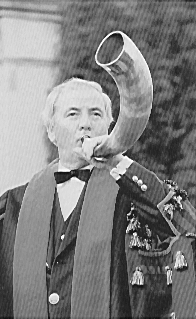This is from the booklet The Inner Temple: A Brief Historical Description by J. H. Baker, K.C., LL.D., F.B.A. published in 1991 and some practices have changed since this booklet was published. For current practice see the Inn’s website.
Besides the academical and vocational exercises required of candidates for the Bar, there have always been social duties to be performed. The custom of eating together in Hall helps to foster a sense of community and continuity, at all levels of the society. Until the later seventeenth century the Inns of Court were residential law schools, and students were required to keep a certain number of terms (and learning vacations) by being physically present in the Inn. At certain times of the year, especially Christmas, keeping term also included participation in the ‘revels’, which included a stately measure paced around the fire (a survival of the medieval hove-dance), and ‘the old song of mirth and solace’.
The age-old test of residence is presence at dinner in Hall on a certain number of days. Exact definition became necessary only when residence in the true sense ceased. In the seventeenth century the requirement was four years in commons, but in 1762 by agreement between the four inns this was reduced to twelve terms, and thus it remained until 1968, when it was further reduced (as a general rule) to eight. In 1798 the number of dinners required for keeping a term was fixed as three, and that (with certain qualifications) has remained the rule until the present. A dinner is counted only if the student is present when grace is said before and after the meal. The grace before dinner is, Benedictus benedicat; and after dinner, Benedicto benedicatur.
The custom of blowing a horn to summon members to Hall is first recorded in 1621, and the Inn possesses a horn dated 1786. The practice of horn-blowing was discontinued in 1886 when the then Head Porter ran short of breath, though in 1937 Master MacKinnon presented a new horn and the custom enjoyed a brief revival.

Gowns are still worn in Hall. They were formerly required in the Church as well, and in all public places. The student’s gown, which dates from the sixteenth century, has wings on the shoulders instead of sleeves, and a flap on the back. The Bar gown was formerly of fine black cloth, with black velvet decoration; but in 1685 a mourning gown of black stuff was adopted on the death of Charles II, and this has been used ever since. The most distinctive feature of the gown is the diminutive black mourning hood worn over the left shoulder. In the seventeenth century the benchers (or at least those who had been readers) wore more elaborate gowns with black lace and tufts; but these did not survive. Benchers now wear the gowns of judges and queen’s counsel, or (if not so entitled) the Bar gown.
The Inn has a fine collection of plate, which is displayed on ceremonial occasions and guest days. The oldest item is a silver-gilt standing cup in the form of a melon or pomegranate, supported on tendrils; it was made by William Holborne in 1563, and the records show that it was bought by the Inn in that year for £20. Most of the old silver went missing during the civil war, when the Inn was largely deserted, and some later pieces have been sold or exchanged in more recent times. The collection was substantially augmented from the bequest of Master Schiller (d. 1946).
Next chapter: The Inn’s Officers and Employees
Back to: Constitution of the Inn

